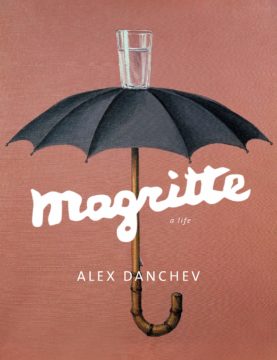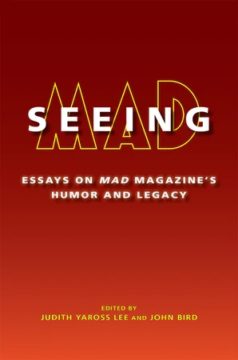Charles Darwent at Literary Review:
 The instant recognisability of Magritte’s work has its roots not in his training at the Académie Royale des Beaux-Arts in Brussels from 1916 to 1918 but in his postwar work as a draughtsman in the city from 1922 to 1926. During this time he made artworks for advertising companies and designed wallpaper and posters. The skills garnered from the first two of these are immediately evident in Golconda, now in the Menil Collection in Houston, Texas. The bowler-hatted men, part Thomson and Thompson, part Gilbert and George, are as obviously Magritte’s logo as the part-eaten apple is that of a certain American computer giant. His eye for pattern was also acute. Golconda would make lovely wallpaper, and no doubt has.
The instant recognisability of Magritte’s work has its roots not in his training at the Académie Royale des Beaux-Arts in Brussels from 1916 to 1918 but in his postwar work as a draughtsman in the city from 1922 to 1926. During this time he made artworks for advertising companies and designed wallpaper and posters. The skills garnered from the first two of these are immediately evident in Golconda, now in the Menil Collection in Houston, Texas. The bowler-hatted men, part Thomson and Thompson, part Gilbert and George, are as obviously Magritte’s logo as the part-eaten apple is that of a certain American computer giant. His eye for pattern was also acute. Golconda would make lovely wallpaper, and no doubt has.
The Menil’s Golconda is an anomaly in being unique, hand-made and identifiable – an autograph work. It is the millions of mass-printed posters of the picture that are arguably the real Golconda, banal and yet everywhere, like the little grey men they depict.
more here.

 Depending on the outcome of social conflicts, ants of the species Harpegnathos saltator do something unusual: they can switch from a worker to a queen-like status known as gamergate. Now, researchers reporting in the journal Cell on November 4th have made the surprising discovery that a single protein, called Kr-h1 (Krüppel homolog 1), responds to socially regulated hormones to orchestrate this complex social transition.
Depending on the outcome of social conflicts, ants of the species Harpegnathos saltator do something unusual: they can switch from a worker to a queen-like status known as gamergate. Now, researchers reporting in the journal Cell on November 4th have made the surprising discovery that a single protein, called Kr-h1 (Krüppel homolog 1), responds to socially regulated hormones to orchestrate this complex social transition. “Ever since I have been at court,” exclaimed the vidame, “the queen has always treated me with much distinction and amiability, and I have reason to believe she has had a kindly feeling for me. Yet there was nothing marked about it, and I had never dreamed of other feelings toward me than those of respect. I was even much in love with Madame de Themines. The sight of her is enough to prove that a man can have a great deal of love for her when she loves him—and she loved me.
“Ever since I have been at court,” exclaimed the vidame, “the queen has always treated me with much distinction and amiability, and I have reason to believe she has had a kindly feeling for me. Yet there was nothing marked about it, and I had never dreamed of other feelings toward me than those of respect. I was even much in love with Madame de Themines. The sight of her is enough to prove that a man can have a great deal of love for her when she loves him—and she loved me. In 1966, I was a junior at St. Louis’s Kirkwood High. After the teachers let us monkeys out at 2:50, I lazed about, often trekking to a friend’s home to talk antiwar politics or Salinger stories. I was a serious kid, some days lying on one of the twin beds in Ken Klotz’s room (his unlucky brother off in Vietnam) where we were hypnotized by Bob Dylan’s Blonde on Blonde and the literary dazzle of “Visions of Johanna”: “The ghost of electricity howls from the bones of her face.” But then some days I needed a break.
In 1966, I was a junior at St. Louis’s Kirkwood High. After the teachers let us monkeys out at 2:50, I lazed about, often trekking to a friend’s home to talk antiwar politics or Salinger stories. I was a serious kid, some days lying on one of the twin beds in Ken Klotz’s room (his unlucky brother off in Vietnam) where we were hypnotized by Bob Dylan’s Blonde on Blonde and the literary dazzle of “Visions of Johanna”: “The ghost of electricity howls from the bones of her face.” But then some days I needed a break. But Berlin is also a city receptive to wanderers conversing with death, loners who find themselves at the end of the road. For the Polish reader, there is no more important description of Berlin, of its mood, people, and places—all of them passed by with equal haste—than the fragments, from 1963, of Witold Gombrowicz’s diary. These pages offer a valuable introduction to the city; reading them carefully sends shivers down the spine. It is necessary to treat them as a standard of free writing and of a literature always on the side of life, though also one that is drawn towards life’s final moments.
But Berlin is also a city receptive to wanderers conversing with death, loners who find themselves at the end of the road. For the Polish reader, there is no more important description of Berlin, of its mood, people, and places—all of them passed by with equal haste—than the fragments, from 1963, of Witold Gombrowicz’s diary. These pages offer a valuable introduction to the city; reading them carefully sends shivers down the spine. It is necessary to treat them as a standard of free writing and of a literature always on the side of life, though also one that is drawn towards life’s final moments. His styles are legion—well organized in this show by the curators Scott Rothkopf, in New York, and Carlos Basualdo, in Philadelphia, with contrasts and echoes that forestall a possibility of feeling overwhelmed. Each place tells a complete story. Regarding early work, New York gets most of the Flags and Philadelphia most of the Numbers. Again, looking rules, as in the case of my favorite paintings of Johns’s mid-career phase, spectacular variations on color-field abstraction that present allover clusters of diagonal marks—that is, hatchings. These are often misleadingly termed “crosshatch,” even by Johns himself, but the marks never cross. Each bundle has a zone of the picture plane to itself, to keep his designs stretched flat, while they are supercharged by plays of touch and color and sometimes poeticized with piquant titles: “Corpse and Mirror,” for example, or “Scent.”
His styles are legion—well organized in this show by the curators Scott Rothkopf, in New York, and Carlos Basualdo, in Philadelphia, with contrasts and echoes that forestall a possibility of feeling overwhelmed. Each place tells a complete story. Regarding early work, New York gets most of the Flags and Philadelphia most of the Numbers. Again, looking rules, as in the case of my favorite paintings of Johns’s mid-career phase, spectacular variations on color-field abstraction that present allover clusters of diagonal marks—that is, hatchings. These are often misleadingly termed “crosshatch,” even by Johns himself, but the marks never cross. Each bundle has a zone of the picture plane to itself, to keep his designs stretched flat, while they are supercharged by plays of touch and color and sometimes poeticized with piquant titles: “Corpse and Mirror,” for example, or “Scent.” For months, during the main
For months, during the main  It’s been more than 50 years since
It’s been more than 50 years since  The idea of epiphany summons two thoughts, generally. One is religious: the sudden and overwhelming appearance of the Divine into everyday life, as experienced, for instance, by Julian of Norwich, Teresa of Avila, and many holy figures through the ages. The other is literary. Epiphany is now perhaps as strongly, or even more strongly, connected to a certain idea expressed in European modernism, and emphasized in its aftermath. The idea is especially prominent in Joyce’s two early prose works, Dubliners—which includes “The Dead”—and Portrait of the Artist as a Young Man. Epiphany, as understood by Joyce, and practiced thereafter, has to do with heightened sensation and flashes of insight, often of the kind that helps a character solve a problem. This is the definition he gave the term, in an early version of Portrait of the Artist as a Young Man: “a sudden spiritual manifestation.”
The idea of epiphany summons two thoughts, generally. One is religious: the sudden and overwhelming appearance of the Divine into everyday life, as experienced, for instance, by Julian of Norwich, Teresa of Avila, and many holy figures through the ages. The other is literary. Epiphany is now perhaps as strongly, or even more strongly, connected to a certain idea expressed in European modernism, and emphasized in its aftermath. The idea is especially prominent in Joyce’s two early prose works, Dubliners—which includes “The Dead”—and Portrait of the Artist as a Young Man. Epiphany, as understood by Joyce, and practiced thereafter, has to do with heightened sensation and flashes of insight, often of the kind that helps a character solve a problem. This is the definition he gave the term, in an early version of Portrait of the Artist as a Young Man: “a sudden spiritual manifestation.” As the coronavirus pandemic recedes in the advanced economies, their central banks increasingly resemble the proverbial ass who, equally hungry and thirsty, succumbs to both hunger and thirst because it could not choose between hay and water. Torn between inflationary jitters and fear of deflation, policymakers are taking a potentially costly wait-and-see approach. Only a progressive rethink of their tools and aims can help them play a socially useful post-pandemic role.
As the coronavirus pandemic recedes in the advanced economies, their central banks increasingly resemble the proverbial ass who, equally hungry and thirsty, succumbs to both hunger and thirst because it could not choose between hay and water. Torn between inflationary jitters and fear of deflation, policymakers are taking a potentially costly wait-and-see approach. Only a progressive rethink of their tools and aims can help them play a socially useful post-pandemic role. Edward Said loved music, and I loved his love of music as well as the musicality that characterized everything he did. Because of his writings on late style, I think of him in connection with Beethoven’s String Quartet no. 15, op. 132. This was Beethoven’s thirteenth quartet, but the fifteenth in order of publication. It’s the kind of work that tempts one to agree with the strange notion that there is such a thing as pure music, music better than any possible performance. This is a romantic idea, and it’s probably not true, since music exists in the hearing, not on the page. But listening to Beethoven’s Op. 132, you can see why people think so. Within the written tradition of Western classical music, as in all genres of music, there is music that exhausts superlatives. Late Beethoven emerges coherently out of mature Beethoven, and mature Beethoven is an extension and fulfillment of early Beethoven. These are major shifts and distinct modes of evolution, but they are not radical breaks.
Edward Said loved music, and I loved his love of music as well as the musicality that characterized everything he did. Because of his writings on late style, I think of him in connection with Beethoven’s String Quartet no. 15, op. 132. This was Beethoven’s thirteenth quartet, but the fifteenth in order of publication. It’s the kind of work that tempts one to agree with the strange notion that there is such a thing as pure music, music better than any possible performance. This is a romantic idea, and it’s probably not true, since music exists in the hearing, not on the page. But listening to Beethoven’s Op. 132, you can see why people think so. Within the written tradition of Western classical music, as in all genres of music, there is music that exhausts superlatives. Late Beethoven emerges coherently out of mature Beethoven, and mature Beethoven is an extension and fulfillment of early Beethoven. These are major shifts and distinct modes of evolution, but they are not radical breaks. Any account of childhood written by an adult might quickly become a work of adult art, presenting the child’s world, its highlights and its shadows, with a sensibility foreign to the experiences of being young. With his intensely concentrated gaze and voluptuous yet exact prose style, however, Wollheim offers us a work of vivid immediacy. Reading it, one experiences the kind of embarrassment that the critic Christopher Ricks identified in Keats’s poetry: Brought this close up to what it feels like to be a child, or for that matter an adult, Wollheim helps us see with awful clarity what an emotional and moral predicament it is to be alive.
Any account of childhood written by an adult might quickly become a work of adult art, presenting the child’s world, its highlights and its shadows, with a sensibility foreign to the experiences of being young. With his intensely concentrated gaze and voluptuous yet exact prose style, however, Wollheim offers us a work of vivid immediacy. Reading it, one experiences the kind of embarrassment that the critic Christopher Ricks identified in Keats’s poetry: Brought this close up to what it feels like to be a child, or for that matter an adult, Wollheim helps us see with awful clarity what an emotional and moral predicament it is to be alive. Electric vehicles have the potential
Electric vehicles have the potential